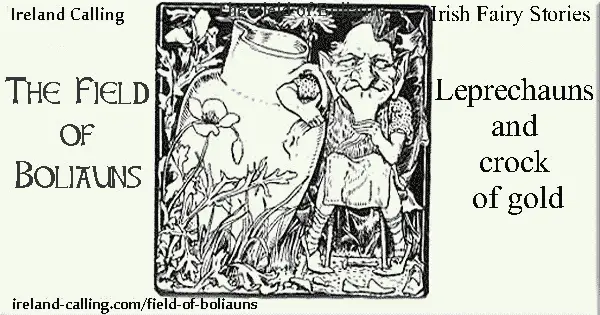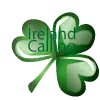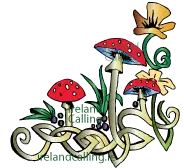Introduction: The Field of Boliauns is one of many Irish fairy stories about humans and leprechauns meeting and attempting to outwit each other.
In this short tale, Tom Fitzpatrick is out walking when he sees a leprechaun drinking beer in a hedgerow.

The pleasant chat soon turns nasty when Tom realises that leprechauns often hoard gold.
He threatens to kill the leprechaun unless he reveals where his treasure is buried. Frightened, the leprechaun takes Tom to a field boliauns – yellow ragwort.
He points out the spot but Tom realises he will have to fetch a spade so he can dig.
He ties a red garter round the boliaun marking the spot and threatens the leprechaun with death if dared to touch the garter.
The leprechaun does as his told…but still manages to pull a trick that makes it impossible for Tom to find the treasure when he returns.
More on the Field of Boliauns.

This is the version as told by Joseph Jacobs in Irish Fairy Tales (1891-94)
ONE fine day in harvest—it was indeed Lady-day in harvest, that everybody knows to be one of the greatest holidays in the year—Tom Fitzpatrick was taking a ramble through the ground, and went along the sunny side of a hedge; when all of a sudden he heard a clacking sort of noise a little before him in the hedge.
“Dear me,” said Tom, “but isn’t it surprising to hear the stonechatters singing so late in the season?”
So Tom stole on, going on the tops of his toes to try if he could get a sight of what was making the noise, to see if he was right in his guess.

The noise stopped; but as Tom looked sharply through the bushes, what should he see in a nook of the hedge but a brown pitcher, that might hold about a gallon and a half of liquor; and by-and-by a little wee teeny tiny bit of an old man, with a little motty of a cocked hat stuck upon the top of his head, a deeshy daushy leather apron hanging before him, pulled out a little wooden stool, and stood up upon it, and dipped a little piggin into the pitcher, and took out the full of it, and put it beside the stool, and then sat down under the pitcher, and began to work at putting a heel-piece on a bit of a brogue just fit for himself.
“Well, by the powers,” said Tom to himself, “I often heard tell of the Lepracauns, and, to tell God’s truth, I never rightly believed in them—but here’s one of them in real earnest.
“If I go knowingly to work, I’m a made man. They say a body must never take their eyes off them, or they’ll escape.”
Tom now stole on a little further, with his eye fixed on the little man just as a cat does with a mouse. So when he got up quite close to him, “God bless your work, neighbour,” said Tom.
The little man raised up his head, and “Thank you kindly,” said he.
“I wonder you’d be working on the holiday!” said Tom.
“That’s my own business, not yours,” was the reply.
“Well, may be you’d be civil enough to tell us what you’ve got in the pitcher there?” said Tom.
“That I will, with pleasure,” said he; ”it’s good beer.”
“Beer!” said Tom. “Thunder and fire! where did you get it?”
“Where did I get it, is it? Why, I made it. And what do you think I made it of?”
“Devil a one of me knows,” said Tom; but of malt, I suppose, what else?”
“There you’re out. I made it of heath.”
“Of heath!” said Tom, bursting out laughing; “sure you don’t think me to be such a fool as to believe that?”

“Do as you please,” said he, “but what I tell you is the truth. Did you never hear tell of the Danes.”
“Well, what about them?” said Tom.
“Why, all the about them there is, is that when they were here they taught us to make beer out of the heath, and the secret’s in my family ever since.”
“Will you give a body a taste of your beer?” said Tom.
“I’ll tell you what it is, young man, it would be fitter for you to be looking after your father’s property than to be bothering decent quiet people with your foolish questions. There now, while you’re idling away your time here, there’s the cows have broke into the oats, and are knocking the corn all about.”
Tom was taken so by surprise with this that he was just on the very point of turning round when he recollected himself; so, afraid that the like might happen again, he made a grab at the Lepracaun, and caught him up in his hand; but in his hurry he overset the pitcher, and spilt all the beer, so that he could not get a taste of it to tell what sort it was.
He then swore that he would kill him if he did not show him where his money was.
Tom looked so wicked and so bloody-minded that the little man was quite frightened; so says he, “Come along with me a couple of fields off, and I’ll show you a crock of gold.”
So they went, and Tom held the Lepracaun fast in his hand, and never took his eyes from off him, though they had to cross hedges and ditches, and a crooked bit of bog, till at last they came to a great field all full of boliauns, and the Lepracaun pointed to a big boliaun, and says he, “Dig under that boliaun, and you’ll get the great crock all full of guineas.”

Tom in his hurry had never thought of bringing a spade with him, so he made up his mind to run home and fetch one; and that he might know the place again he took off one of his red garters, and tied it round the boliaun.
Then he said to the Lepracaun, “Swear ye’ll not take that garter away from that boliaun.” And the Lepracaun swore right away not to touch it.
“I suppose,” said the Lepracaun, very civilly, “you have no further occasion for me?”
“No,” says Tom; “you may go away now, if you please, and God speed you, and may good luck attend you wherever you go.”
“Well, good-bye to you, Tom Fitzpatrick,” said the Lepracaun; “and much good may it do you when you get it.”
So Tom ran for dear life, till he came home and got a spade, and then away with him, as hard as he could go, back to the field of boliauns; but when he got there, lo and behold! not a boliaun in the field but had a red garter, the very model of his own, tied about it; and as to digging up the whole field, that was all nonsense, for there were more than forty good Irish acres in it.
So Tom came home again with his spade on his shoulder, a little cooler than he went, and many’s the hearty curse he gave the Lepracaun every time he thought of the neat turn he had served him.

More on the Field of Boliauns
The leprechaun wins the day in The Field of Boliauns but that is not the case in all Irish fairy stories. Humans often with the battle of wits, as in the story of Guleesh, who manages to rescue a princess from the fairy people.
Jacobs gives his source for the Field of Boliauns as T. Crofton’s Fairy Legends of the South of Ireland, as edited by Wright. He said that in the original version, the gnome is a cluricaune, which was similar to a leprechaun but more surly, wrinkly and with a reputation for drinking wine and being constantly drunk.
However, John D Batten, who provided the original artwork for Irish Fairy Stories, said a friend of his had heard the story told about a leprechaun so Jacobs adapted it to that version.
Hear The Field of Boliauns being told here
More on Irish Art
Ancient history
More history articles
The Neolithics – first people to leave their mark on Ireland